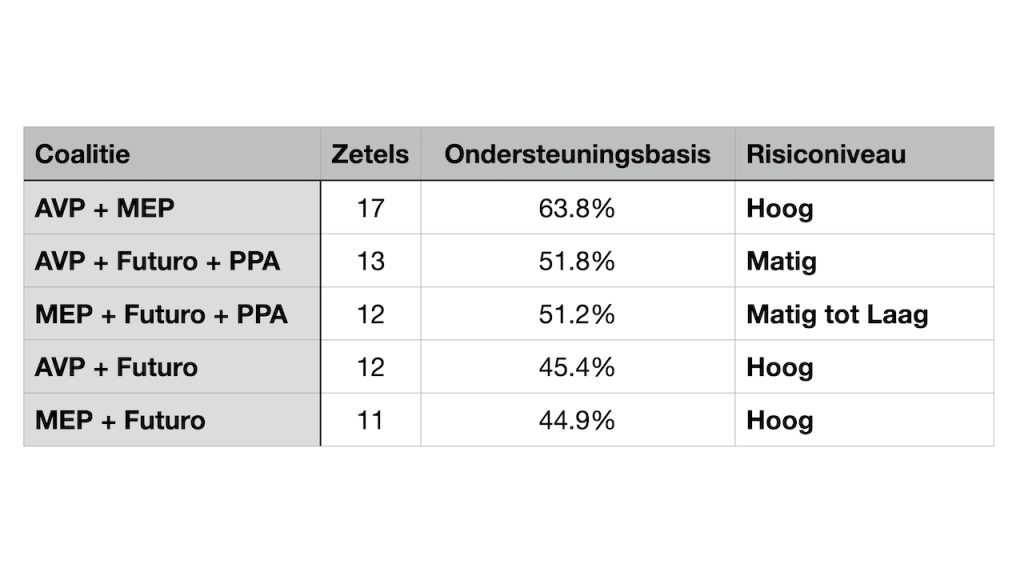
Coalitions in a multiparty system such as Aruba's require delicate negotiations and trust between parties. Based on the data provided, the risks of conflict can be assessed using the stability(number of seats), support base (percentage of votes) and political compatibility (historical relations and ideological agreement).
1. AVP + MEP (Seats: 17; Support: 63.8%)
Advantages:
- High stability: With 17 seats (a clear majority) and broad voter support, this coalition is numerically the most stable.
- Joint governance: Combining the two largest parties can streamline decision-making and reduce political gridlock.
Risks of conflict:
- Historical rivalry: AVP and MEP are traditional rivals, which makes cooperation challenging. Prolonged political tensions can complicate trust and cooperation.
- Policy differences: Differences in priorities, such as economic strategies (AVP's pro-business approach versus MEP's focus on social justice), can lead to frequent conflicts.
- Leadership struggle: Disagreement over who should fill the role of prime minister and other key positions could lead to gridlock.
General risk: High. Although the numerical majority provides stability, deep ideological and historical differences make this coalition prone to internal conflict.
2. AVP + Futuro + PPA (Seats: 13; Support: 51.8%)
Advantages:
- Majority coalition: With 13 seats, this coalition reaches a majority, offering moderate stability.
- Reform Agenda: FUTURO and PPA may encourage AVP to embrace reform-oriented policies, which may be attractive to a wider audience.
Risks of conflict:
- Power imbalance: The dominance of AVP (9 seats) may overshadow the smaller parties, leading to resentment and feelings of marginalization.
- Policy differences: FUTURO's reform-oriented agenda may clash with AVP's traditional approach, causing friction over policy priorities.
- Limited cohesion: With three different parties, coordination and decision-making may be slower, increasing the likelihood of internal conflict.
General risk: Moderate. Although the coalition reaches a majority, balancing the interests of three parties can strain relations.
3. MEP + Futuro + PPA (Seats: 12; Support: 51.2%)
Advantages:
- Progressive tuning: MEP and FUTURO share reform-oriented values, which can promote smoother cooperation.
- Moderate stability: 12 seats make for a narrow majority, but provide ample room for coordinated governance.
Risks of conflict:
- Ambition Conflicts: FUTURO may insist on a prominent role to prove its worth, which may clash with MEP's established leadership.
- Role of PPA: As the smallest partner, PPA may struggle to achieve its agenda, which can cause tension or disinterest.
- Policy coordination: Although MEP and FUTURO can agree on reforms, differences in priorities or methods can lead to disagreement.
General risk: Moderate to low. With shared values between MEP and FUTURO, this coalition has potential for smoother cooperation, although the role of PPA may cause some complications.
4. AVP + Futuro (Seats: 12; Support: 45.4%)
Advantages:
- Simple structure: A two-party coalition simplifies decision-making compared to larger coalitions.
- Potential for reform: FUTURO may encourage AVP to take a more modern, reformist course, which may appeal to younger and progressive voters.
Risks of conflict:
- Numerical instability: With only 12 seats, this coalition has a narrow majority, making it vulnerable to defection or dissidence.
- Ideological mismatch: FUTURO's reform-oriented views can clash with AVP's traditional policies, leading to frequent disagreements.
- Power dynamics: The dominance of AVP (9 seats) may marginalize FUTURO, causing frustration and dissatisfaction.
General risk: High. The narrow majority and ideological differences make this coalition vulnerable to instability and internal conflict.
5. MEP + Futuro (Seats: 11; Support: 44.9%)
Advantages:
- Policy compatibility: MEP and FUTURO share reform-oriented goals, which can streamline decision-making on important issues.
- Reform-oriented leadership: FUTURO can strengthen MEP's progressive agenda, appealing to reform-minded voters.
Risks of conflict:
- Weak majority: With only 11 seats, this coalition will struggle to maintain parliamentary support.
- Leadership tensions: FUTURO may insist on a significant role, which may cause friction with MEP's established leadership.
- Voter Support: With a support base of only 44.9%, the coalition may struggle to maintain public confidence.
General risk: High. The narrow majority and potential leadership conflicts make this coalition fragile and prone to instability.
Summary of Risk Levels
| Coalition | Seats | Support base | Risk level |
|---|---|---|---|
| AVP + MEP | 17 | 63,8% | High |
| AVP + Futuro + PPA | 13 | 51,8% | Moderate |
| MEP + Futuro + PPA | 12 | 51,2% | Moderate to Low |
| AVP + Futuro | 12 | 45,4% | High |
| MEP + Futuro | 11 | 44,9% | High |
Key Insights
- Most stable option: AVP + MEP offers the greatest numerical and voter support, but has a high risk of ideological and historical conflict.
- Best choice for FUTURO: MEP + Futuro + PPA has the lowest risk of conflict, with shared reform values and manageable coordination challenges.
- High-risk coalitions: AVP + Futuro and MEP + Futuro are both fragile because of their tight majorities and potential leadership conflicts.

